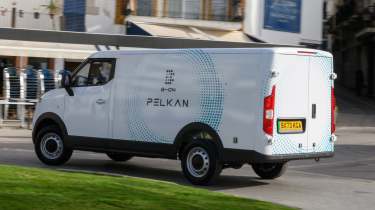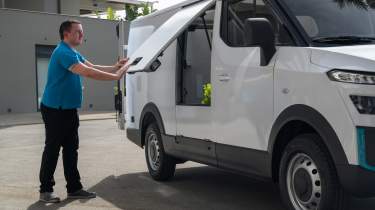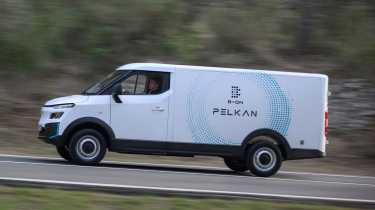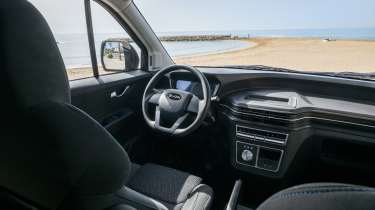B-ON Pelkan van review: back-to-basics EV van with small bills
B-ON promises to be a fleet manager’s dream, but the Pelkan is only so-so for the driver
The electric van market is already filled with solid entries from established manufacturers like Ford and Renault, as well as some appealing newcomers such as the LEVC VN5. This hasn’t deterred B-ON, though, as this Luxembourg-based brand believes its first-ever van, the B-ON Pelkan, has an edge that the competition has barely even considered.
Although it’s a brand-new name on UK roads, B-ON launched back in 2020 as a ‘mobility solutions’ provider offering fleet management and energy storage services. In essence, the brand has taken something of a reverse approach by focussing on its infrastructure-related products prior to building its first van, rather than the other way around. It’s these pre-established services that B-ON believes will give the Pelkan a unique advantage against an ever-increasing number of electric van options, such as the Ford E-Transit, Maxus eDeliver 9, Renault Master E-Tech and Vauxhall Movano Electric.
B-ON is going all-in on its belief that the Pelkan will appeal to big businesses by starting out with a focus on bulk fleet orders, rather than individual sales. This may change in the not-too-distant future, depending on the Pelkan’s initial sales performance, but for now it's the big last-mile delivery fleets that the Pelkan is being squarely aimed at.
The line-up consists of two variants named the 43 and 54, and these are named after the 43.5kWh and 53.6kWh battery packs that power them. These batteries have official claimed ranges of 141 and 174 miles respectively, while both variants are powered by the same single 114bhp motor.
While these figures are fairly middling, the B-ON Pelkan does have a not-so-secret weapon: a maximum payload of up to 1,350kg and 7.1 cubic metres of cargo space. Look at it from the front and you’d be forgiven for thinking that the Pelkan is a fairly compact van as it’s only 1,850mm wide and 2,047mm in height. This is a bit deceiving, though. Take a look around the back and you’ll quickly see that it’s a whopping 5,457mm long, which is very close in size to the Ford E-Transit’s 5,531mm length.
It's at the rear where this is most obvious as there’s a big overhang due to the 3,380mm wheelbase. These unusual proportions mean the Pelkan looks a bit peculiar from certain angles, but this sense of function over form is a consistent theme throughout B-ON’s first van.
Nobody has ever uttered the phrase “wow, that courier’s van is in mint condition”, and B-ON is well aware that every Pelkan sold is probably going to take a hammering throughout its working life. To keep repair times and costs down, the Pelkan’s body panels are made from reinforced aluminium, and feature very little in the way of styling flair.
This sense of modesty continues on the inside, too. There are no trim levels offered (in fact the only option is the battery size) and the Pelkan’s interior quickly reinforces the fact that this van is built with cost-effectiveness in mind, rather than plushness. Apart from the 10.1-inch central touchscreen, the layout is a very basic one with hard and scratchy plastics in abundance. The brand is targeting last-mile delivery drivers that will be hopping in and out of the cabin all day, and it’s a good job because the Pelkan is far from a luxurious place to sit.
Overall, the Pelkan is an interesting road-going debut from B-ON. Rather than focussing on delivering car-like characteristics or creature comforts, it has instead been designed as a simple tool to get the job done. Look at it like this and it should appeal to cost and emissions-wary last-mile fleet managers. It’ll also mean drivers can be a bit less worried about picking up scuffs and scrapes.
For anyone else, though, this is a very Spartan vehicle that fails to come close to the modern comforts of the mainstream electric vans. Simplicity and cost-effectiveness are the order of the day here, and a low price, as well as the value of B-ON’s additional fleet and energy management services.
B-ON is aiming for a starting price of around £30,000 to £33,000, which would indeed undercut a number of similarly-sized electric mainstream models, but only time will tell if this is enough.
Efficiency, range and running costs
The intended pricing for the B-ON Pelkan is set to be around £30,000 to £33,000. If this is the case, it would undercut the smaller Maxus eDeliver 3 which starts from £34,000. It’d also undercut several other mainstream electric vans such as the Citroen e-Dispatch, Peugeot e-Expert, Renault Trafic E-Tech and Mercedes eVito, all of which sit above the £35,000 mark.
It’ll cost around £10.80 to fully charge the 43.5kW variant at a typical electricity rate of 25p per kWh. This will increase to around £13.40 for Pelkans fitted with the 53.6kWh unit.
When it comes down to how many miles you’ll get for your money, the base 43.5kW battery has a claimed maximum range of 141 miles on the WLTP combined cycle, and this climbs to 174 miles for the larger 53.6kWh pack.
Provided that the production model will return these figures in the real world, both batteries should prove adequate for last-mile delivery drivers who are hopping around urban streets all day (the Pelkan’s intended customer), but it’ll be a bit touch-and-go if a driver ever needs to take a longer motorway trip. Its 68mph maximum speed means they’ll need to have their foot to the floor on the motorway.
When it’s time to top-up, B-ON claims that a 30-80 per cent rapid charge will take less than 35 minutes at a rate of 60kW. It also says that hooking the Pelkan up to a slow charger will take around eight hours to charge the 43.5kWh battery from zero to 100 per cent, or around 10 hours for the larger 53.6kWh pack.
Most delivery vans cover plenty of miles over a short period of time, so components can get worn out rather quickly. Obviously, electric vans are fitted with far fewer moving parts than traditional diesel-powered vehicles, so this helps towards keeping maintenance costs down. When it comes to perishables, B-ON has continued its apparent utility over beauty approach by fitting the Pelkan with chunky plastic bumpers, basic steel wheels and skinny tyres — all of which should prove reasonably cheap to replace.
Load space and practicality
Brand loyalty is strong in the van world, so B-ON needs to pull a real ace out of its sleeve in order to tempt customers away from the establishment and towards the brand-new and virtually unknown Pelkan. Fortunately, the brand seems to have played this ace in the area that’s likely to be the most important to its last-mile target market: cargo capacity.
Both variants of the Pelkan offer a generous 7.1 cubic metres of cargo volume, which has been achieved by making this van 5,457mm long. Compare this figure to the Pelkan’s 2,047mm height and 1,850mm width and it does look quite stretched in appearance — again, utility is the goal here rather than cosmetic appeal.
This lengthy body sits on a 3,380mm wheelbase, so the rear doors sit quite far away from the rear axle. The load lip sits at around shin height, making it easy to both load and board the Pelkan from the back.
It’s the same story with the side door, too, as this sits equally low but, rather than a traditional sliding door, B-ON has opted to fit what it calls a ‘side shutter door’. This consists of two hatches: one top hatch which can be opened on its own like a tailgate, and another smaller hatch which can then be opened downwards to allow full access. This setup is similar to the one used at the back of a Range Rover.
The brand claims that its ‘side shutter door’ is quicker to use than a traditional sliding door, but the top hatch is still fairly heavy to lift. It also requires quite a bit of space in order to open, so obstacles such as lamp posts or parked cars could get in the way. It’s difficult to see any particular advantage here over a traditional sliding side door.
The rear doors, on the other hand, are conventionally designed and equally sized. The rear-hinges allow these to open up to 270-degrees, so they don’t get in the way. Once opened, external (and rather unsightly) pins need to be used in order to hold the doors in place once opened. B-ON claims that it is considering replacing these pins with magnets or improved hinges in response to initial customer feedback. If this does happen, it’d be a notable improvement both practically and physically.
Along with its unusual side door, the Pelkan is also set to receive another party piece: B-ON’s Smart Dispenser system. Sadly, this wasn’t fitted to our test van, but this motorised rotating shelf system is being designed to automatically sort packages and have them ready-picked to unload as soon as the van arrives at its destination. The system is set to run via the Pelkan’s GPS technology, and it could indeed be a very useful tool for couriers. However, being a hefty electronically-operated system, this will need to be efficient so it doesn’t come at the cost of all-important battery range.
Inside the cabin, there are a few useful cubbies for smaller items such as a tablet or documents, and the cupholder should also hold a chunky thermal flask for those essential cups of tea. There aren’t any innovative storage solutions to be found here, though.
Reliability and safety
The B-ON Pelkan’s utilitarian and low-cost approach may help to keep costs down in the long run, but it also results in the sacrifice of a lot of modern safety equipment.
Both versions of the Pelkan come with a driver’s airbag and seatbelts, and that’s pretty much it. Although it has two seats up front, the B-ON is clearly assuming that Pelkans won’t be carrying passengers very often as there’s no airbag on the left-hand side (nor a doorbin or sun visor for that matter).
Although there is a window in the bulkhead which allows the driver to keep an eye on the cargo bay, there are no rear windows. As previously mentioned, the Pelkan is a long vehicle, so reversing it safely is a bit challenging as the door mirrors are only basic with no additional blind spot magnification. However, a reversing camera will be included in the production model in order to make this particular task a bit easier.
Electric vehicles are far more straightforward mechanically than their combustion-powered counterparts, so there is less to go wrong, but it remains to be seen just how well the Pelkan will hold up as it racks up the miles.
Driving and performance
Although their batteries vary in size, both the 45 and 52 variants offer the exact same performance figures from the shared single motor powertrain. With 114bhp and 260Nm of torque on tap, the Pelkan has an official top speed of 68mph.
While it’s not about to win any load-lugging drag races, our test van did feel reasonably brisk whenever some extra boost was needed, such as when overtaking. However, when pulling away from a standstill, there’s a bit of a delay between pressing the accelerator pedal and anything actually happening. This becomes particularly frustrating when attempting to pull out into fast-moving traffic. Once it does kick in, the electric motor is noticeably loud but not excessively so.
Although there is a regenerative braking system, this is non-adjustable and we barely felt it in operation. This means that single-pedal driving is out of the question, and you will need to manually brake just like you would in a diesel van.
It hasn’t been built with motorway cruising in mind, but the Pelkan is reasonably smooth on the open road. As soon as it hits a moderately-sized imperfection in the tarmac, though, the ride does get rather bouncy but it isn’t intolerable for a van of this size.
Hit the city streets and the Pelkan’s relatively compact width means narrower roads remain mostly stress free. In the bends, the electric power steering is extremely light, so turning requires very little effort. This is a good thing, too, as the 13.9-metre turning circle means three-point turns can quickly grow into multiple-point turns.
Cab and interior
B-ON has designed the Pelkan to be cost-effective and hard-wearing rather than plush and decorative, and this is most apparent by far when it comes to the interior. Dark, solid plastics are prevalent throughout the cabin, and while these are sensible in terms of longevity, they are far from inviting to look at.
The centrepiece of the otherwise basic dashboard is a 10.1-inch touchscreen. Although the system in our test van was only a demonstrator, the graphics and layout were clear enough (although slightly dated compared to some other recent systems) and the software was responsive to inputs. The essentials are all included, too, such as Apple CarPlay and Android Auto connectivity, Bluetooth and a DAB radio.
The instrument display is also digital, but this is displayed on a smaller and much more basic segmented display screen. While it’s not the most sophisticated setup by today’s standards, all of the information is easy enough to decipher. There’s no live efficiency information, though, which could make economic driving a bit more difficult.
Elsewhere, the centre console switchgear is treated to a splash of silver in an apparent attempt to make the Pelkan feel a little bit more upmarket. However, it still feels quite cheap to the touch. Strangely, the dashboard-mounted rotary gear selector is chrome-like in its appearance, which does look a bit chintzy and out of place. When it comes to kit, things are kept equally basic but air-conditioning is included as standard.
As most of B-ON’s intended customers will be jumping in and out of the Pelkan all day, it’s unlikely that they’ll have too much time to appreciate the seats. However, there is a decent level of comfort to be enjoyed when it’s time to take a pew. This newcomer isn’t about to frighten the likes of Mercedes on the comfort front, but the Pelkan’s drivers shouldn’t find themselves worrying too much about backache.
If the Pelkan is the first step of a driver's transition to electric power, there is a reassuring sense of familiarity about the controls. A good old-fashioned flipkey is used to start it, and there’s a proper manual handbrake. Once again, there’s nothing groundbreaking here, just straightforward stuff that actually works, and this is a rule which pretty much sums up the Pelkan as a whole.






